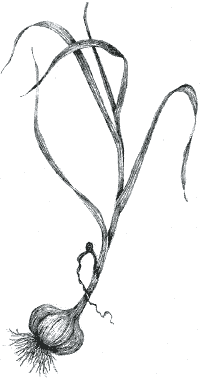How to Use Garlic as a Natural Pesticide
Contents
Garlic, Allium sativum
After the Garlic, Allium sativum, natural pesticide booklet produced by HDRA - the organic organisation
Description
Garlic originated in Central Asia and has now spread across the world. For use as an insecticide it should not be grown using chemical fertilisers. This is because heavy doses of fertiliser reduce the concentration of the effective substances in the garlic. It has anti-feedant, bacterial, fungicidal, insecticidal, nematicidal and repellent properties.
Preparations
• Garlic spray
Blend 100 grams of grated and crushed garlic cloves, 0.5 litres of water and 10 grams of soap (Use potash based soft soap that is used for washing dishes and not the modern washing powders that contain caustic soda which will harm plants). Mix well. Strain the mixture through a fine cloth. Dilute the solution in 5 litres of water.
How to use: Mix the solution well before applying to the affected plants. Use as a spray or sprinkle using twigs or grass tied together to form a whisk. For best effect, use the mixture immediately.
Garlic is effective against a wide range of diseases and insects at different stages in their life cycle (egg, larvae, adult). This includes ants, aphids, army worms, caterpillars, Colorado beetle, diamondback moth, pulse beetle, whitefly, wireworm, false codling moth, imported cabbage worm, khapra beetle, mice, mites, moles, Mexican bean beetle, peach borers and termites as well as fungi and bacteria.
Nematodes can also be controlled by drenching the soil with garlic liquid. However this method may also kill many beneficial soil bacteria and insects.
Garlic is effective against so many pests and diseases that different strengths may need to be experimented with.
Note'': The taste of garlic will remain on sprayed plants for one month after spraying so it may be best to avoid spraying near harvest time.
• Garlic powder spray
Crush and grind dried garlic bulbs. The powder can be used directly onto affected plants. A useful spray can also be made. To do this, add the powder to water and mix well. The amount of garlic powder needed depends on how strong the garlic is.
How to use: This mixture is useful against scab, mildew, bean rust and tomato blight.
• Chillis and garlic spray
Grind 1 garlic bulb and 1 onion. Add 1 tablespoon of powdered chilli peppers. Stir into 2 litres of hot water. Leave the mixture to cool. Strain through a fine cloth and keep the liquid. Add 1 tablespoon of soft soap and stir well. Use potash based soft soap that is used for washing dishes and not the modern washing powders that contain caustic soda that will harm plants.
How to use: Use as a spray for caterpillars in fruit trees.
• Garlic and Tephrosia vogelii spray
Pound fresh Tephrosia leaves and dried garlic leaves into a paste with a little water. Stir 50g of this mixture into 1 litre of water. Mix well, sieve and keep the liquid.
How to use: Use the solution as a spray against cabbage worm. Use 1 litre per square metre. Apply once every week until 2 weeks before harvesting of the crop.
Other uses of garlic
Intercropping: Traditionally garlic has been intercropped with many crops. This strong smelling plant hides the smell of the crop it is planted with. Intercropped with cabbage, garlic may deter the diamondback moth. Also, planting 4 rows of sorghum with 7 rows of garlic helps to prevent shootfly infestations.
Garlic can also be planted around fruit trees to repel aphids, fruit tree borers, termites, mice and other pests.
WARNING: Garlic is a broad spectrum insecticide. This means that it will kill beneficial insects as well as pests. Try to spray only the affected areas where pests are doing most damage.
Difficulties
Success Story
Plans, Illustrations, Posters
Contacts
HDRA - the organic organisation, Ryton Organic Gardens Coventry, CV8 3LG, UK Tel: +44 (0)24 7630 3517 Fax: +44 (0)24 7663 9229 Email: ove-enquiry@hdra.org.uk Website: http://www.hdra.org.uk
Links
Link to Fourthway's poster "How to make a natural pesticide": http://www.fourthway.co.uk/posters/pages/pesticide.html
Bibliography
Related Articles
- How to Use Neem as a Natural Pesticide
- How to Control Termite without Chemicals
- How to Process Oilseed on a Small Scale
- How to Use Garlic as a Natural Pesticide
- How to Use Chillies as a Natural Pesticide
Two ways to support the work of howtopedia for more practical articles on simple technologies:
Support us financially or,
Testimonials on how you use howtopedia are just as precious: So write us !
<paypal />
Categories
- Agriculture
- Fruits
- Insects
- Pest control
- Tree
- Vegetables
- Biodiversity
- Easy
- Global Technology
- Global
- Less than 10 US$
- Chillies
- Garlic
- Seedlings
- One Person and more
- Household
- Village
- Neighbourhood
- Application
- Howtopedia requested images
- Requested translation to Spanish
- Requested translation to French
- Requested translation to Hindi
- Requested translation to Portuguese
